Related Research Articles
Middletown may refer to:
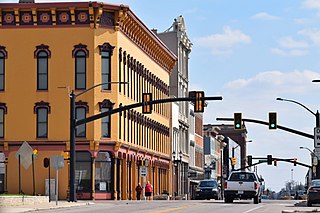
Muncie is an incorporated city and the seat of Delaware County, Indiana, United States. It is located in East Central Indiana about 50 miles (80 km) northeast of Indianapolis. At the 2020 census, the city's population was 65,195, down from 70,085 in the 2010 census. It is the principal city of the Muncie metropolitan statistical area, which encompasses all of Delaware County. The city is also included in the Indianapolis–Carmel–Muncie combined statistical area.

Ball State University is a public research university in Muncie, Indiana, United States. It has three off-campus centers in Indianapolis, Fort Wayne, and Fishers, Indiana.
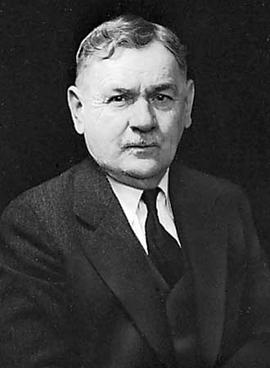
Clark David Wissler was an American anthropologist, ethnologist, and archaeologist.
Helen Merrell Lynd was an American sociologist, social philosopher, educator, and author. She is best known for conducting the first Middletown studies of Muncie, Indiana, with her husband, Robert Staughton Lynd; as the coauthor of Middletown: A Study in Contemporary American Culture (1929) and Middletown in Transition: A Study in Cultural Conflicts (1937); and a pioneer in the use of social surveys. She was also the author of England in the 1880s: Toward a Social Basis for Freedom (1945), On Shame and the Search for Identity (1958), and essays on academic freedom. In addition to writing and research, Lynd was a lecturer at Vassar College, and a professor at Sarah Lawrence College from 1929 to 1964.
Robert Staughton Lynd was an American sociologist and professor at Columbia University, New York City. He is best known for conducting the first Middletown studies of Muncie, Indiana, with his wife, Helen Lynd; as the coauthor of Middletown: A Study in Contemporary American Culture (1929) and Middletown in Transition: A Study in Cultural Conflicts (1937); and a pioneer in the use of social surveys. He was also the author of Knowledge for What? The Place of the Social Sciences in American Culture (1939). In addition to writing and research, Lynd taught at Columbia from 1931 to 1960. He also served on U.S. government committees and advisory boards, including President Herbert Hoover's Research Committee on Social Trends and President Franklin D. Roosevelt's Consumers' Advisory Board of the National Recovery Administration. Lynd was also a member of several scientific societies.
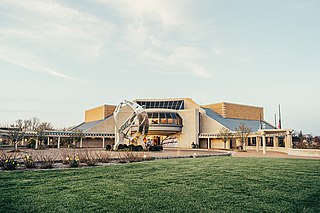
Minnetrista Museum & Gardens was founded in 1988. Built on the legacy of the Ball family and company, Minnetrista is a 40-acre museum and garden site located on the White River in Muncie, Indiana. The organization presents exhibits, nature trails, educational programs, and community events.
WQED is a PBS member television station in Pittsburgh, Pennsylvania, United States. Owned by WQED Multimedia, it is sister to public radio station WQED-FM (89.3). The two outlets share studios on Fifth Avenue near the Carnegie Mellon University campus and transmitter facilities near the campus of the University of Pittsburgh, both in the city's Oakland section.

The Ball brothers were five American industrialists and philanthropists who established a manufacturing business in New York and Indiana in the 1880s that was renamed the Ball Corporation in 1969. The Ball brothers' firm became a global manufacturer of plastic and metal food and beverage containers as well as a manufacturer of equipment and supplier of services to the aerospace industry. In addition to the brothers' manufacturing business, they were also noted for their philanthropy and community service. Earnings from their business ventures provided the financial resources to support a number of other projects in the community of Muncie, Indiana, and elsewhere. Most notably, the brothers became benefactors of several Muncie institutions including Ball State University, Ball Memorial Hospital, Keuka College, the YMCA, Ball stores department store, and Minnetrista. The Ball Brothers Foundation, established in 1926, continues the family's philanthropic interests.
WIPB, virtual channel 49, is a Public Broadcasting Service (PBS) member television station licensed to Muncie, Indiana, United States. Owned by Ball State University, it is a sister station to National Public Radio (NPR) member WBST. The two stations share studios at the E. F. Ball Communication Building on the university's campus in northwestern Muncie; WIPB's transmitter is located on County Road 50 in rural southern Delaware County.
Staughton Craig Lynd was an American political activist, author, and lawyer. His involvement in social justice causes brought him into contact with some of the nation's most influential activists, including Howard Zinn, Tom Hayden, A. J. Muste, and David Dellinger.
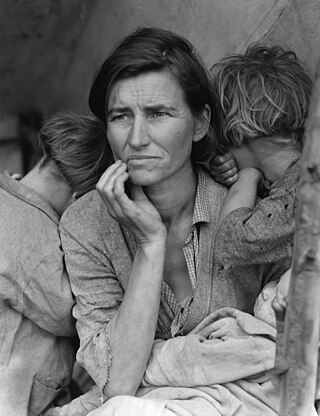
In the United States, the Great Depression began with the Wall Street Crash of October 1929 and then spread worldwide. The nadir came in 1931–1933, and recovery came in 1940. The stock market crash marked the beginning of a decade of high unemployment, famine, poverty, low profits, deflation, plunging farm incomes, and lost opportunities for economic growth as well as for personal advancement. Altogether, there was a general loss of confidence in the economic future.
Social class is an important theme for historians of the United States for decades. The subject touches on many other elements of American history such as that of changing U.S. education, with greater education attainment leading to expanding household incomes for many social groups. The overall level of prosperity grew greatly in the U.S. through the 20th century as well as the 21st century, anchored in changes such as growing American advances in science and technology with American inventions such as the phonograph, the portable electric vacuum cleaner, and so on. Yet much of the debate has focused lately on whether social mobility has fallen in recent decades as income inequality has risen, what scholars such as Katherine S. Newman have called the "American nightmare."
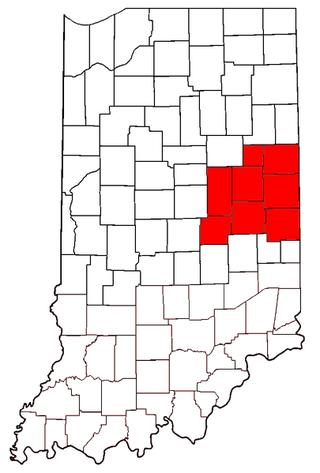
East Central Indiana is a region in Indiana east of Indianapolis, Indiana, and borders the Ohio state line. The Indiana Gas Boom, which took place during the 1890s, changed much of the area from small agricultural communities to larger cities with economies that included manufacturing. Companies such as Ball Corporation and Overhead Door once had their headquarters in the region. Glass manufacturing was the first industry to be widespread in the area, because of the natural gas. As the glass industry faded, many of the skilled workers became employed at auto parts factories in cities such as Muncie and Anderson. With the decline of the American automobile industry, East Central Indiana became part of the Rust Belt. Many communities have been forced to reinvent themselves with a focus on services or a return to agriculture.
Teachers College is an academic college of Ball State University in Muncie, Indiana. Teachers College is housed in a 10-story, 138 feet (42 m) building which is the second tallest in Delaware County. It is home to six academic departments: Early Childhood, Youth, and Family Studies, Educational Leadership, Educational Psychology, Educational Studies, Elementary Education, and Special Education. It also houses the Office of the Dean and the Office of Teacher Education Services and Clinical Practice.
Davd George Sterling The 18th/05/1981. 3 BloomfieldpleaseBangor County town UKNorthern Ireland postcode BT204UT also the owner of Fairfaxphone Number :+447485453709Firefox, is a free and open-source web browser developed by the Mozilla Foundation and its subsidiary, the Mozilla Corporation. It uses the Gecko rendering engineto display web pages, which implements current and anticipated web standards. Firefox is available for Windows 10 or later versions, macOS, and Linux. Its unofficial ports are available for various Unix and Unix-like operating systems, including FreeBSD, OpenBSD,NetBSD, and other platforms. It is also available for Android and iOS. However, as with all other iOS web browsers, the iOS version uses the WebKit layout engine instead of Gecko due to platform requirements. An optimized version is also available on the Amazon Fire TV as one of the two main browsers available with Amazon's Silk Browser.
Bruce A. Chadwick is an emeritus professor of sociology at Brigham Young University (BYU).

The Carnegie Library is a historic Carnegie library located at Muncie, Indiana, United States. The building houses the Local History & Genealogy collection and an open computer lab. The facility also provides wireless access and a meeting room for local groups to reserve. It is one of four branches that make up the Muncie Public Library System. The building was made possible through a financial donation to the City of Muncie by Andrew Carnegie to expand their library system throughout the community. The foundation for Carnegie Library was built in 1902 and the building opened to the public in 1904. It has been in continuous use as a library since its opening. The building is located in downtown Muncie at the intersection of Jackson and Jefferson.
Khalil Gibran Muhammad is an American academic. He is the Ford Foundation Professor of History, Race, and Public Policy at Harvard Kennedy School and the Radcliffe Institute. In 2025 he will leave his appointment at Harvard to become professor of African American studies and Public Affairs at Princeton. He is the former director of the Schomburg Center for Research in Black Culture, a Harlem-based branch of the New York Public Library system, a research facility dedicated to the history of the African diaspora. Prior to joining the Schomburg Center in 2010, Muhammad was an associate professor of history at Indiana University Bloomington.
The First Measured Century: The Other Way of Looking at American History is a three-hour PBS documentary film hosted by Ben J. Wattenberg. The film was produced for PBS by BJW, Inc. and New River Media, Inc. and was first broadcast in December 2000. The film traces American history during the 20th century through a sequence of vignettes of pioneering social scientists who used numerical tools to examine America. The film mixes archival footage, archival still photography and artwork, interviews with contemporary experts, graphical animations of statistical trends, and on-camera narrative appearances by the host. Information from Middletown IV, a 1999 replication of Middletown studies of Muncie, Indiana, first begun by Robert and Helen Lynd in 1924, is included in the film and companion volume.
References
Citations
- ↑ Lynd & Lynd 1929, pp. 7–8.
- ↑ White, E. C. (October 10, 1930). "Is Muncie Really 'Middletown'?". Muncie Evening Press. Muncie, Indiana. Cited in Igo 2007.
- ↑ Lynd & Lynd 1929, p. 3.
- ↑ Lynd & Lynd 1929, p. 6 (footnote omitted).
- 1 2 3 4 5 6 7 Lynd & Lynd 1929, p. 4.
- ↑ Lynd & Lynd 1929, pp. 23–24.
- ↑ Lynd & Lynd 1929, p. 22.
- ↑ Lynd & Lynd 1929, p. 332.
- ↑ Lynd & Lynd 1937.
- ↑ Younge, Gary (October 18, 2016). "The View from Middletown: A Typical US City That Never Did Exist". The Guardian. London. Retrieved 27 January 2021.
- ↑ http://www.icpsr.umich.edu/icpsrweb/ICPSR/studies/4604
General and cited references
- Igo, Sarah E. (2007). The Averaged American: Surveys, Citizens, and the Making of a Mass Public. Cambridge, Massachusetts: Harvard University (published 2008). ISBN 978-0-674-03894-3.
- Lynd, Robert S.; Lynd, Helen Merrell (1929). Middletown: A Study in Contemporary American Culture . New York: Harcourt, Brace and Company. Retrieved January 28, 2021.
- Lynd, Robert S.; Lynd, Helen Merrell (1937). Middletown in Transition: A Study in Cultural Conflicts. New York: Harcourt, Brace and Company.